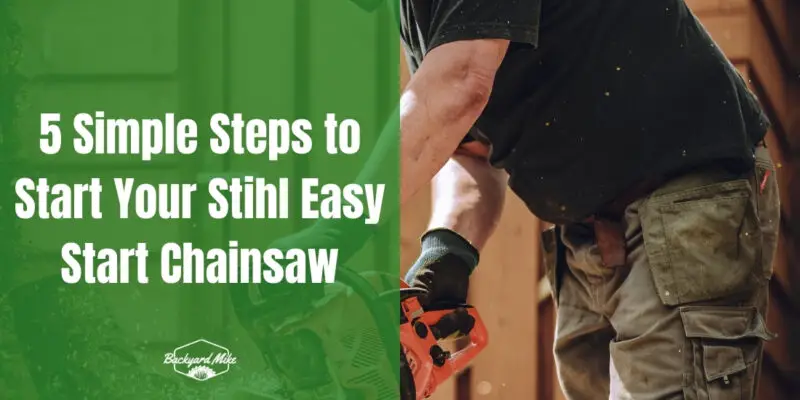To start your Stihl Easy Start Chainsaw, first, wear essential safety gear like a helmet, protective glasses, and chaps. Next, place the chainsaw on a flat surface and check fuel and oil levels. Confirm all safety features, like the chain brake and guard, are functioning. Pull the starter cord until resistance is felt, following model-specific starting procedures. Finally, after starting, verify chain tension and inspect for unusual noises or vibrations. There's more to explore for ideal operation tips.
Key Takeaways
- Place the chainsaw on a level surface, ensuring the chain does not touch the ground.
- Pull the starter cord until resistance is felt to engage the Easy2Start system.
- Set the Master Control Lever to full choke for a cold engine or warm start for a warm engine.
- Press the primer bulb 2-3 times, taking care not to over-prime the engine.
- Activate the chain brake before starting to ensure safety and proper function.
Gear Up for Safety
Before starting your Stihl chainsaw, it's essential to gear up for safety to protect yourself from potential hazards. Equip yourself with the right safety gear, beginning with a helmet featuring a visor and earmuffs. This protective equipment shields your head and ears from impacts and excessive noise. Make sure your helmet meets ANSI Z89.1 and EN397 standards, and choose one with high visibility colors for added safety. For eye protection, wear safety glasses with side shields and an anti-UV coating, ensuring they've hard-coated lenses and non-slip frames. Don't forget chainsaw chaps or pants with six layers of protection, oil and water resistance, and compliance with OSHA and ASTM standards. The helmet's interior cushion pad enhances comfort during use, ensuring you can focus on the task at hand without discomfort. Chainsaw chaps are essential protective gear that can prevent life-threatening injuries in case of an accident. Finally, opt for cut-resistant boots with rubber soles for ideal traction.
Prepare Your Chainsaw
To prepare your chainsaw for use, start by placing it on a flat, stable surface to guarantee it's well-supported. This step is essential for confirming your chainsaw maintenance routine begins safely. Make certain the cutting attachment remains off the ground, preventing the chain from dulling. Position the rear handle between your legs or against your foot for leverage, and grip the front handle firmly with your left hand. This setup provides stability while your right hand remains free to operate the starter cord. Before starting, check the fuel mixture—it's critical for proper engine function. Verify the fuel tank is filled, and the bar and chain lubricant tank are ready. Safety measures help prevent accidents during use, so always ensure the working area is clear of hazards and properly ventilated. Familiarize yourself with your model's starting procedure, as it may vary. Keep in mind the anti-vibration system found in many Stihl models to reduce user fatigue while operating the chainsaw.
Engage Safety Features
Once your chainsaw is prepared, it's important to engage the safety features to guarantee a secure operation.
Start with safety training and equipment maintenance. Wear protective gear like eye and ear protection, gloves, and protective legwear.
Check the chain's condition; it should be fitted, tensioned, and sharpened. Confirm your bar and chain oil levels are adequate. Remember, the depth gauge ensures the correct height to reduce aggressiveness and minimize kickback risk.
Safety labels should be visible; replace them if worn. Verify the chain brake and catcher, right-hand guard, and anti-vibration mount are functioning correctly. Consider investing in chainsaws with safety features, as they are more cost-effective than potential hospital bills.
Clear your work area of obstacles, and stay aware of potential hazards. Recognize your personal limitations, and avoid operating in poor weather.
Regular maintenance confirms all these safety features work together, keeping you safe during operation.
Follow the Starting Sequence
Starting your Stihl chainsaw requires following a precise sequence to guarantee safety and efficiency.
Begin by placing your chainsaw on level ground, making certain the chain doesn't touch the ground. Engage the Easy2Start system by pulling the starter cord slowly until you feel resistance, then pull quickly and forcefully. For a cold engine, set the Master Control Lever to full choke; for a warm engine, use the warm start setting. Prime the engine by pressing the primer bulb 2-3 times, but avoid over-priming. Press the decompression valve if your model includes one. Ensure the chain brake is activated by pushing it forward before attempting to start the engine.
Once started, adjust the lever to the half-choke position, allowing the engine to warm up by idling briefly. This guarantees peak performance and prepares your chainsaw for use.
Conduct Post-Startup Checks
After successfully starting your Stihl chainsaw, it's crucial to conduct post-startup checks to verify safety and peak performance. These post-startup procedures are essential for effective chainsaw maintenance. Begin by checking the following:
- Chain Brake Status: Confirm the chain brake works correctly and can be engaged and disengaged smoothly.
- Chain Lubrication: Run the chain at half throttle over a light surface to validate proper lubrication with visible oil trails.
- Saw Chain Condition: Inspect the chain for proper tension and sharpness, adjusting as needed. Regular maintenance, such as using STIHL Service Kits, plays a vital role in ensuring the efficiency and safety of your chainsaw.
- Engine Performance: Listen for unusual noises or vibrations, indicating potential issues.
Address any discrepancies immediately, confirming your chainsaw is in prime condition before use. This proactive approach fosters a sense of community and safety among fellow chainsaw users.
Frequently Asked Questions
How Often Should I Sharpen the Chainsaw Chain?
You should sharpen your chainsaw chain after every tank of gas. Regular chain maintenance using proper sharpening techniques guarantees peak performance. Join the community of skilled users who value safety and efficiency in their tools.
What Type of Fuel Is Recommended for Stihl Chainsaws?
You'll want to use a fuel mixture of at least 89 octane gasoline with no more than 10% ethanol for your Stihl chainsaw. This choice guarantees peak performance and keeps you part of the well-informed chainsaw community.
Can I Use a Stihl Chainsaw in Wet Conditions?
Picture a dance in the rain. Yes, you can use your Stihl chainsaw in wet conditions. Prioritize safety precautions and follow maintenance tips. With proper care, you'll keep your chainsaw performing like a trusted partner.
How Do I Store My Chainsaw When Not in Use?
When storing your chainsaw, focus on chainsaw maintenance and storage precautions. Drain fuel, clean thoroughly, and store it in a dry, ventilated area. Keep it upright in a protective case to guarantee it's ready for future use.
What Is the Ergostart Feature on Stihl Chainsaws?
Did you know 90% of users find starting easier with ErgoStart? This feature's benefits include reduced strain and reliable starts. The ErgoStart mechanism employs a spring to store energy, making startup effortless. You're joining a savvy community!
Conclusion
With your chainsaw in hand, you've navigated the path of preparation and precision. Each step, like a link in a chain, guarantees your safety and the tool's readiness. You've donned your gear, checked the machine, and engaged its safeguards. Following the starting sequence, you've brought your chainsaw to life. Now, conduct the post-startup checks, confirming everything runs smoothly. With these steps, you wield a powerful tool, ready to tackle the tasks ahead with confidence.


